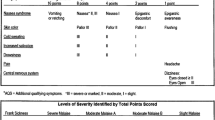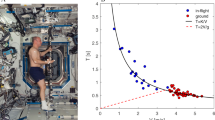Summary
Illusions of self motion and aircraft motion are experienced when executing deep knee bends in the high force phases of parabolic flight. The occurrence of such illusions indicates that skeletomotor control is actively calibrated to a 1 g reference level and that departures from this level affect the execution and appreciation of voluntary movements. The origin of the illusory patterns is shown to be understandable in terms of “mismatches” between efferent control signals and expected patterns of associated muscle spindle activity. It is shown, too, that spindle activity is interpreted within an entire context of spatial information about ongoing and intended motion of the body and whether the body is laden.
Similar content being viewed by others
References
Goodwin G, McCloskey D, Matthews P (1972a) Proprioceptive illusions induced by muscle vibration. Contribution to perception by muscle spindles? Science 175: 1382–1384
Goodwin G, McCloskey D, Matthews P (1972b) The contribution of muscle afferents to kinesthesia shown by vibration-induced illusions of movement and by paralyzing joint afferents. Brain 95: 705–748
Granit R (1972) Constant errors in the execution and appreciation of movement. Brain 95: 649–660
Greenwood R, Hopkins A (1976) Landing from an unexpected fall and a voluntary step. Brain 99: 375–386
Lackner J, Graybiel A (1980) Visual and postural motion aftereffects following parabolic flight. Aviat Space Environ Med 51: 230–233
Lackner J, Levine M (1978) Visual direction depends on the operation of spatial constancy mechanisms. Neurosci Lett 7: 207–212
Lackner J, Levine M (1979) Changes in apparent body orientation and sensory localization induced by vibration of postural muscles. Vibratory myesthetic illusions. Aviat Space Environ Med 50: 346–354
Melvill Jones G, Watt D (1971a) Observations on the control of stepping and hopping movements in man. J Physiol (Lond) 219: 709–727
Melvill Jones G, Watt D (1971b) Muscular control of landing from unexpected falls in man. J Physiol (Lond) 219: 729–737
Author information
Authors and Affiliations
Additional information
Supported by NASA contracts NAS9-15147 and T-9140E
Rights and permissions
About this article
Cite this article
Lackner, J.R., Graybiel, A. Illusions of postural, visual, and aircraft motion elicited by deep knee bends in the increased gravitoinertial force phase of parabolic flight. Exp Brain Res 44, 312–316 (1981). https://doi.org/10.1007/BF00236568
Received:
Issue Date:
DOI: https://doi.org/10.1007/BF00236568




